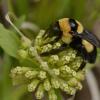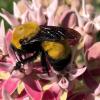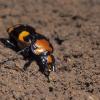
The callippe silverspot was historically found around the eastern, southern, and western sides of San Francisco Bay, but is now limited to just seven sites. It is found in native grassland and adjacent habitats, where females lay their eggs on the larval food plant, Johnny-jump-up. The causes of the callippe silverspot’s decline are fairly clear: The vast majority of potential butterfly habitat lies under the cities of San Francisco, Oakland, and Berkeley, and what open areas remain within this butterfly’s range are dominated by introduced plant species. Many of these areas are also grazed by cattle, mined, or subject to heavy recreational use.
Taxonomic Status
(Lepidoptera: Nymphalidae: Argynninae)
Speyeria callippe callippe (Boisduval), 1852. Common names include callippe fritillary.
The callippe silverspot is a medium-sized butterfly in the family Nymphalidae (brushfoots). It has a wingspan of about 2¼ inches (56 mm). The dorsal wings are brown with extensive black spots and lines, and the basal areas are extremely dark. The ventral sides are brown, orange-brown, and tan with black lines and distinctive black and bright silver spots. The basal areas of the wings and body are densely hairy. The caterpillars are darkcolored with many branching sharp spines on their backs.
Females lay their eggs on the dry remains of the larval food plant, Johnny-jump- up (Viola pedunculata), or on the surrounding debris. After about a week of feeding, caterpillars (larvae) wander a short distance and spin a silk pad upon which they spend the summer and winter. In the spring they immediately seek out Johnny-jump-up plants. In May they grow, shedding their skins four times. The pupa is formed within a chamber of leaves that the caterpillar has drawn together with silk. It emerges as an adult in about two weeks and lives in this life stage for about three weeks. Depending upon environmental conditions, this period ranges from mid-May to late July. The adults seek the top of a hill to mate.
Historically, this butterfly inhabited grasslands ranging over much of the San Francisco Bay region. On the eastern shore of San Francisco Bay, the butterflies were found in the inner coast range from northwestern Contra Costa County south to the Castro Valley area in Alameda County. On the west side of the Bay, it ranged from San Francisco south to the vicinity of La Honda in San Mateo County. The species was known to occur in seven major populations. Five of these, including the one located at Twin Peaks in San Francisco, are extirpated and the butterfly is now relegated to only two populations scattered over seven threatened sites.
The callippe silverspot is found in native grassland and adjacent habitats.
Xerces Society Red List Status: Critically Imperiled
Other Rankings:
Canada – Species at Risk Act: N/A
Canada – provincial status: N/A
Mexico: N/A
USA – Endangered Species Act: Endangered
USA – state status: N/A
NatureServe: G5T1
IUCN Red List: N/A
The callippe silverspot was listed as a Federal Endangered Species on December 5, 1997 (Federal Register 62:64306). Monitoring of San Bruno Mountain populations in 2000 indicate that numbers appear to be stable. No new information from 2001 supported change in status.
Recovery Plan (ESA): none.
Critical Habitat (ESA): none designated.
The California Endangered Species Act does not allow listing of insects, so despite the precarious status of the callippe silverspot, it has no protection under state legislation. The California Department of Fish and Game includes this butterfly on its Special Animals list.
The causes of the callippe silverspot’s decline are fairly clear: The vast majority of potential butterfly habitat lies under the cities of San Francisco, Oakland, and Berkeley, and what open areas remain within this butterfly’s range are dominated by introduced plant species. Many of these areas are also grazed by cattle, mined, or subject to heavy recreational use. The Alameda County population is particularly small and vulnerable. The San Bruno Mountain population occurs on land that, although private, is largely protected from development. This area is also being managed for the conservation of several additional endangered species, including the San Bruno elfin (Callophrys mossii bayensis) and the bay checkerspot (Euphydryas editha bayensis). (See Red List profiles for more information on these two butterflies.)
The species is imperiled by the current and potential future destruction and alteration of its habitat due to off-road vehicle use, unsuitable levels of livestock grazing, and invasive exotic vegetation. Trampling by off-road vehicles and by horses and hikers could also crush the food plants of the larvae or the adult nectar sources. Use of insecticides may also be a problem.
Longcore, T., C. S. Lam, and J. P. Wilson. 2004. Analysis of Butterfly Survey Data and Methodolgy from San Bruno Mountain Habitat Conservation Plan 1. Status and Trends (1982-2000) University of Southern California GIS Research Laboratory and Center for Sustainable Cities, Los Angeles, CA. (Accessed 3/25/05)
Profile prepared by Scott Hoffman Black and Mace Vaughan, The Xerces Society for Invertebrate Conservation.
Citation
Black, S. H., and D. M. Vaughan. 2005. Species Profile: Speyeria callippe callippe. In Shepherd, M. D., D. M. Vaughan, and S. H. Black (Eds). Red List of Pollinator Insects of North America. CD-ROM Version 1 (May 2005). Portland, OR: The Xerces Society for Invertebrate Conservation.





